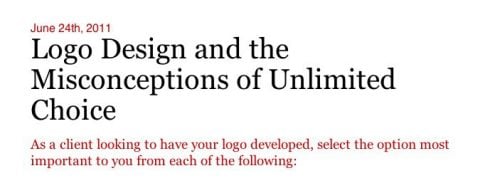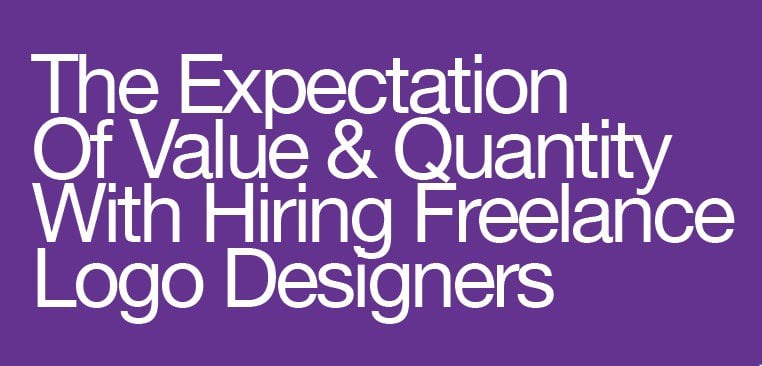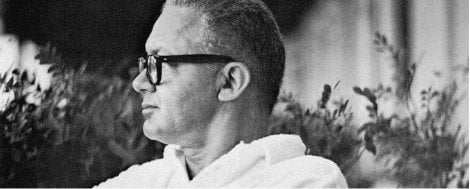
The Expectation Of Value & Quantity With Hiring Freelance Logo Desig
ners
Just had to add my own thoughts to the excellent article over at IDApostle by Steve Zelle: Logo Design and the Misconceptions of Unlimited Choice with freelance logo designers.
Steve touches on some excellent points that we could all do with being aware of in a very concise article. I’m just going to add my side and expand on what Steve has written.
Value = Choice?
As consumers we often associate ‘value’ by what we are getting in return, and that in spending our cash we have a notion that value often equals quantity, choice, selection and variety etc. If we don’t get the choice or selection we were expecting, or assumed to be to be getting, then we can feel we didn’t get value for money.
Logo design is one area where this illusion/expectation of: choice, selection and variety equals value.
Online logo sweat shops—I can’t even bring myself to call them logo designers—offer unlimited choice and reversions until the client is pleased. This is wrong on so many levels and I urge you to read the article by Steve if you have not done so already.
Logo Design Is Not About Choice
Logo design is not about getting a mammouth choice or selection of ideas to choose from. That’s not where the value is. The value is what you are getting as a finished design by the logo designer your hired. If you feel the freelancer logo designer has failed you by not offering a selection of ideas then you don’t quite grasp the notion of what you are asking that designer to do for you in the first place, as well as the designer being at fault for not setting expectations clearly at the outset.
One Idea
I am a firm believer in working hard to find that one winning idea from the outset rather than laying out a pretty selection of 4-6 differing ideas. This idea I will present can sometimes be the first idea or it can be the result of many sketches and brainstorming sessions. I have to be 100% behind this idea before showing any part of it to the client. If after the presentation the client has valid reasons for not liking it or not finding it appropriate then we start again.
To put your valuable time in finding 4-6 different ideas from the outset I believe, as does Steve, is a colossal waste of time and energy which would be better spent finding that one winning idea and perfecting it.
When Hiring Freelance Logo Designers
When you hire a logo designer try not to associate overall value of your investment by how ever many ideas and variations you might be getting ready to see. The value of what you are getting is not directly related to quantity but IS related to quality, and this expectation should be set out from the outset.
A very famous logo designer going by the name of Paul Rand had the right idea, and I briefly talk about his process in this article: Paul Rand Has The Right Idea Design One Logo Only.
One of the quotes by Paul that I particularly find interesting is:
“Simplicity is not the goal. It is the by-product of a good idea and modest expectations.”
Apply that line of thought to client expectations, ensuring that their expectations are modest from the outset, can only be a good thing for the end goal and overall sanity of both designer and client.
If you are confident about what you do then you should have no problem in steering your client towards an acceptable and agreeable expectation of value for money. The value is a logo design that reflects your business/product/company/consultancy in a suitable and appropriate way.
As Steve points out: Invest in the (designer-client) relationship, and a talented and well informed designer will deliver the one effective solution you need.
Hiring Freelance Logo Designers
Pinning down these details is all the more important if you are self-employed or work freelance as a logo designer. Being able to focus your energies on the main idea at hand is so much more productive and beneficial to your energy and motivation than trying to come up with the first round of 4-6 differing concepts.
Even if you can come up with 4 awesome ideas this doesn’t particularly prove anything, or helps you in any perceivable way–except if you like showing off how cool you are with your fast and creative spinning mind. I’d much rather have one awesome idea on the table, one that I have put everything into, than trying to choose one of many.
In the post about Paul Rand I show a few examples where I have focused my energies on early ideas rather than try and impress my client with a selection. In all these cases the client was happy and we were able to spend every minutes tweaking and perfecting it rather than play spin-the-bottle.
It’s up to you to change this expectation to something more humbling and modest just as Paul Rand hints to.
But It’s Not Always That Simple
This isn’t to say that this notion of only working on one idea is always feasible or workable. I still end up getting sucked into a project where my best ideas were turned down and I end up desperate to please. This will mean I might be 20 even 40+ ideas into the project with no end in sight.
This is the worst possible place to be but can be hard to drag yourself out of. Standing your ground with a client can be tricky and uncomfortable at the best of times so this is why it is so very crucial to lay down expecations right at the beginning and try try try not to deviate from that.
If you often find yourself with a reasonably clear idea or thought for a logo design at the beginning then you ought to consider making this the rule rather than the exception and adjust your work-flow accordingly.
Quite often I will get an email from a new client where they are looking forward to seeing a number of ideas. When I get such an email then I will have to reply back and re-calibrate their expectations. It is often hard for a client to accept the idea that they might only get to see one idea with a few variations but this comes down to you the designer to convince them and make them feel secure that this is how it is done.
If Not The 1st Time
It’s important to stress that if the client has valid and genuine concerns over this first big idea, that it’s so far off the reservation that it’s in another solar system, then you will of course listen and re-calibrate your own vision.
It happens and just means that your initial perception or understanding of the brief was just way of, and hopefully the next time round you will be much closer to hitting the target. It’s about setting expectations, being firm, and also giving the reassurance that you are also fair, reasonable and realistic.
What’s The Aim
The overall aim with the idea of focusing on one general direction opposed to providing 4-6 different ideas is: a client unable to choose or tell which is the right option out of their choices; choices are notoriously hard at the best of times so asking a client to make a choice like this can lead to frustation and confusion; to focus the designers mind on working with that one direction and taking it all the way rather than splitting their focus x6; it forces the designer to really work on understanding the company and the brief in order to best meet the clients’ requirements and satisfy any of their personal preferences; wastage of funds based on 3-5 unused ideas that took time and energy to put together, so far better to exert that time and energy in better understanding the brief and their needs the first time around; not having to explain to the client why all 4-6 of your ideas are perfect and worthy of their consideration because they’re probably not, so why did you do them?
To end with.
A designer is not always right and equally the client is not always right. There is room on both sides for the mid-ground.

